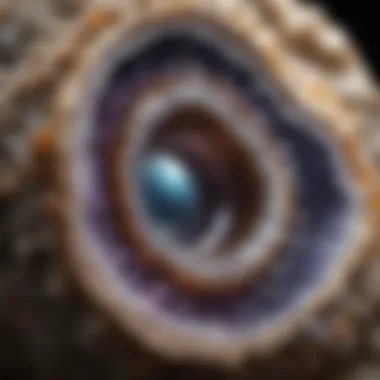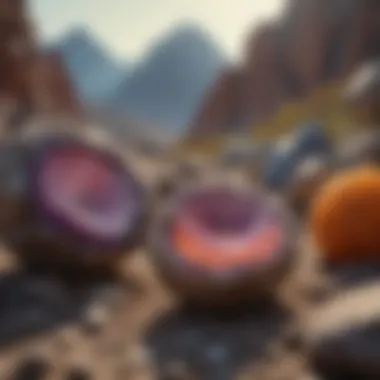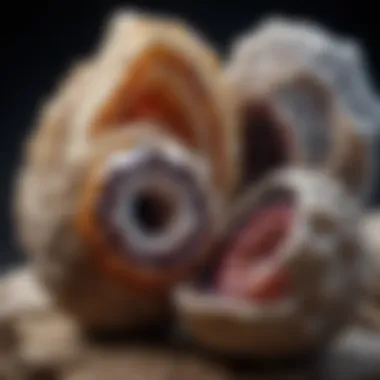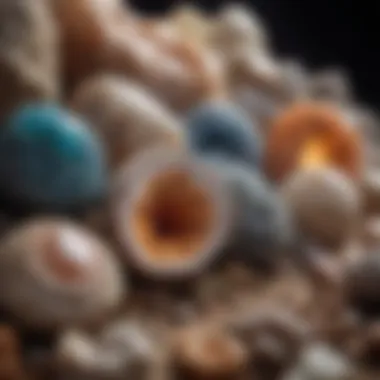Mastering Geode Identification: A Complete Guide


Intro
Geodes are fascinating geological formations. They often hold hidden beauty within their seemingly unremarkable exteriors. To the untrained eye, a geode can resemble a simple rock, or even a bit of mineral-encrusted stone. Yet, concealed within can be vibrant crystals and intricate patterns, making them a prized collectible among hobbyists and researchers alike.
Understanding how to identify geodes is essential for anyone interested in mineral collecting or geology. With the correct guidelines, you can refine your ability to locate and appreciate these natural wonders.
Recognizing geodes involves a few key concepts. First, it's important to know their visual characteristics, as the outer shell can hint at what lies within. Second, having reliable resources at hand can aid in further identification. By mastering these skills, collectors can deepen their engagement with this unique aspect of geology.
This article aims to provide you with the comprehensive knowledge necessary to identify geodes effectively. The information caters not only to seasoned collectors but also to those just beginning their journey into the world of minerals.
Understanding Geodes
Understanding geodes is fundamental for anyone interested in geology, rock collecting, or simply appreciating the natural beauty of these unique formations. Geodes can often appear to be ordinary rocks from the outside, yet they hold significant value for both collectors and researchers. The beauty and variety found within geodes make them a fascinating subject of study. By recognizing their characteristics and formation processes, collectors can enhance their identifying skills and develop a deeper connection with their finds.
Definition of Geodes
A geode is a hollow, often spheroidal rock formation that is lined with minerals or crystals. The exterior can be rough and unassuming, often resembling a common stone, while the interior, when broken open, reveals a stunning array of crystallized materials. These interiors can contain quartz, calcite, amethyst, or other minerals, adding to their appeal for collectors. The geological history of each geode is as diverse as the crystals it contains, making them individual treasures for discovery.
Formation Process
The formation of geodes is a complex natural process that begins in volcanic or sedimentary environments. Typically, a geode forms when mineral-rich water seeps into cavities in the earth. Over thousands of years, this mineral-rich water precipitates and deposits minerals in the cavity. As time passes, layers of crystals form, creating the spectacular interiors that are characteristic of geodes. These processes can take millions of years, and variations in conditions lead to different types of crystals found within. Understanding this formation process is crucial for collectors as it provides insight into the geologic history and the potential value of a geode.
Characteristics of Geodes
Understanding the characteristics of geodes is essential for proper identification and appreciation of these geological formations. By focusing on both external and internal features, collectors can gain insight into the uniqueness of each specimen. The recognition of geodes relies heavily on these characteristics, as they provide distinct identifiers that separate them from other rock types. Collectors who know what to look for can enhance their search and understanding of geodes.
External Features
External features offer the first visual cues for identifying geodes. This includes shape and size as well as the surface texture of the geode.
Shape and Size
Shape is a crucial aspect of geodes. Most are spherical or oblong, but irregular shapes can also occur. The size can vary significantly, from small pebble-sized geodes to massive formations. Collectors often favor larger specimens due to their potential for more extensive crystal growth inside. A key characteristic of geodes is their rounded exterior, which often sets them apart from surrounding rock.
The benefit of identifying geodes by shape is that these formations typically do not resemble any other rocks found in similar environments. However, irregularly shaped specimens may confuse some collectors. They might be mistaken for nodules or other types of rock.
Surface Texture
The texture of a geode's surface can give additional clues. A common characteristic is the smooth, rounded exterior which may have some visible imperfections or pockmarks. This can result from weathering and erosion over time. Smooth textures often indicate a potential for more significant crystal formations inside.
The texture can also influence a collector's decision. A unique feature of some geodes is their glossy surface, which can indicate a rich mineral content. However, not all smooth-textured geodes have vibrant crystals inside. Thus, while the surface texture is an attractive trait, it is not always a definitive indicator of the quality of the internal crystals.
Internal Features
Internal features are vital for assessing the geodes. These give insight into formations' contents and quality. Notably, the type of crystals and color variations are significant aspects to consider.
Type of Crystals
Inside geodes, various crystals can form, including quartz, calcite, and amethyst. These crystals can vary greatly among specimens and are a major aspect of the geode's identity. The presence of distinct types like amethyst can dramatically increase the appeal and value of a geode.
The benefit of knowing the type of crystals is that collectors can make informed decisions on which specimens to pursue. Crystals that exhibit clarity and vibrancy often command higher market value. However, collectors must also be aware that not all crystal types present inside are equally desirable, making knowledge crucial.
Color Variation
Color variation is another fascinating internal feature. Geodes can display a range from vibrant purples to soft pastels, even including clear or smoky varieties. The colors result from different mineral impurities present during crystal formation. A notable characteristic is the way certain colors enhance the visual appeal of a geode.
Collectors typically find value in geodes with rich and uncommon colors, as they are seen as more unique. However, overemphasis on color may lead to overlooking the overall crystal quality. Thus, while color plays a significant role, it is essential to balance this with other attributes.


The understanding of both external and internal features enables a collector to discern the potential value and characteristics of geodes effectively.
In summary, recognizing characteristics is fundamental to identifying geodes. Those interested in geology or collecting can benefit greatly by understanding external features such as shape, size, and surface texture. Internal features like type of crystals and color variation further complement the identification process. Through this knowledge, hobbyists and collectors can enrich their experience and appreciation of these remarkable formations.
Searching for Geodes
Searching for geodes is an essential aspect of the overall process of identifying and collecting these unique geological formations. It involves not only knowing where to look but also understanding the environmental conditions and geological characteristics that favor the presence of geodes. Knowing these elements is critical to maximize one’s chances of finding valuable specimens. Without proper guidance on this topic, collectors may waste time and resources in unproductive areas, which can be frustrating and disheartening.
An effective search strategy can greatly enhance a collector's experience, as finding even one geode can be immensely rewarding. Moreover, knowledge about ideal locations and appropriate tools can make the process both enjoyable and fruitful.
Ideal Locations
Geological Regions
Geological regions play a pivotal role in the search for geodes. These areas are characterized by specific rock types and formation processes that contribute to the development of geodes. Regions like volcanic areas, for instance, are often rich in minerals conducive to geode formation. The key characteristic of these regions is their unique geological history, which influences the types of minerals that can be found within the geodes. For instance, areas with significant volcanic activity often produce geodes containing beautiful quartz or calcite crystals.
The geological process entails the cooling of lava, where gas bubbles can create cavities that develop into geodes over time. This makes them a prime location for collectors eager to find these formations. However, one must consider that accessibility can vary in geological regions, and some may require specific permits for excavation or rock collecting.
Mineral-Rich Areas
Mineral-rich areas are another critical consideration in geode hunting. These regions are identified by the abundance of different minerals, which can indicate the potential presence of geodes. The key characteristic of mineral-rich areas is their complex mineral deposits, which often contain a variety of elements that form crystals within geodes. Mines and areas around mining operations frequently yield geodes filled with quartz, drusy, or other valuable minerals.
These sites can be advantageous for collectors due to the high likelihood of finding geodes. However, it is essential to be aware of the regulations and safety concerns surrounding mined areas. Collecting may be restricted or forbidden in certain locations due to environmental protections or mining operations.
Tools and Equipment
Prospecting Tools
Prospecting tools are indispensable for anyone serious about collecting geodes. These tools facilitate the search and extraction process, making the experience more efficient. A basic set of prospecting tools includes rock hammers, chisels, and sifting screens. However, collectors may benefit from additional items such as digging tools and hand trowels. The primary characteristic of these tools is their design, which allows for precision and reduces the risk of damaging the geodes during extraction.
Using the right tools can significantly improve the success rate of finding and collecting geodes. They enable collectors to safely investigate potential geode sites and extract samples without causing undue harm.
Safety Gear
Safety gear is another crucial aspect of geode collecting. Engaging in rock collecting can expose individuals to various hazards, including sharp rocks and unstable surfaces. The key characteristic of safety gear is its ability to protect collectors from injury during exploration. Basic safety gear should include gloves, safety goggles, and durable footwear. Collectors should also consider helmets if they are exploring areas with the potential for rockfall.
The importance of safety gear cannot be overstated. Accidents can happen quickly in outdoor environments, and the right protective equipment can prevent serious injuries, ensuring a pleasant and secure collecting experience. As the saying goes, it’s better to be safe than sorry.
Methods for Identifying Geodes
Identifying geodes requires a combination of techniques that leverage both visual inspection and physical testing. These methods are important as they empower collectors and enthusiasts with the knowledge to discern between true geodes and other rock types. Utilizing distinct identification techniques enhances the pursuit of these geological treasures and helps to avoid common misidentifications.
Visual Inspection Techniques
Visual inspection plays a critical role in the early stages of identifying geodes. Often, a careful examination can yield significant clues about the nature of the rock in question.
Weight Comparison
Weight comparison is a straightforward but effective method for identifying geodes. Many geodes are hollow and contain only mineral deposits or crystals. Thus, a geode may feel lighter than expected if compared with a solid rock of similar size. This characteristic makes weight comparison a beneficial choice in the identification process.
The unique feature of weight comparison lies in its simplicity. A prospective collector can easily conduct this test in the field. However, it has limitations, as some solid rocks may share a similar weight. Hence, it is advisable to use this technique alongside others for more precise results.
Sound Test
The sound test involves tapping the rock gently and listening for the sound it produces. A geode often emits a different tone compared to solid rocks. This auditory clue helps collectors determine the presence of a hollow cavity inside. The key characteristic of this method is its non-invasive nature, which allows for quick evaluations.
However, the efficacy of the sound test can depend on external conditions, such as surrounding noise. Some may find it less reliable in crowded environments. Still, it serves as a useful preliminary technique to gauge whether further investigation is necessary.


Physical Testing Methods
Physical testing methods delve deeper into the structure of the rock, offering more definitive insights into whether it is a geode.
Breaking a Sample
Breaking a sample is a more drastic approach but can yield crucial information regarding a geode. When the rock is broken, the interior reveals whether it contains crystals or remains solid. This method is often employed by collectors looking for evidence of valuable mineral formations.
The distinct feature of this technique is its directness, providing clear evidence of the rocks' nature. However, it does come with significant disadvantages. Once a sample is broken, it cannot be returned to its original state, which can diminish its aesthetic value and market appeal.
Shining Light Through
Shining light through a rock can be an effective technique to evaluate its contents. If a geode is present, light will often illuminate the interior, revealing crystal formations or cavities. This method relies on the translucence of the rock, making it particularly useful for identifying certain types of geodes.
The primary advantage of this technique is its non-destructive nature. Collectors can assess the rock's interior without damaging it. However, it may not be applicable for all rock types, particularly those that are opaque or very dense.
These methods for identifying geodes require a careful approach. While each technique has its strengths and weaknesses, employing a combination of them leads to more accurate identification and enhances a collector's ability to find genuine specimens.
Distinguishing Geodes from Other Rocks
Understanding the differences between geodes and other types of rocks is crucial for collectors and enthusiasts. Many rock formations can appear similar, leading to misidentification and confusion. This section aims to clarify key differences and ensure that the identification of geodes is accurate.
Common Misidentifications
Geodes are often confused with several types of rocks, due to their external similarities. Common misidentifications include:
- Nodules: Similar shape but lack hollow interiors.
- Limestone: Can appear similar, especially if weathered.
- Other sedimentary rocks: These sometimes have round shapes but do not possess the unique crystal formations.
Such misidentifications can impair a collector's understanding of their finds, so recognizing the nuances is vital.
Key Differentiators
To properly distinguish geodes from these other rocks, understanding their unique characteristics is essential.
Comparison with Nodules
Nodules and geodes can look alike on the outside, but they are fundamentally different. The critical aspect is that nodules are generally solid throughout. They lack the central void that characterizes a geode. This solid mass can sometimes contain minerals, but it does not form crystals in a hollow cavity. This is beneficial in the identification process since geodes often have a rich interior, sometimes coated with quartz or calcite crystals.
Nodules might be favored by those who prefer solid specimens, but their absence of cavities and crystal formations does not enhance their value as geodes do.
Distinction from Limestone
When comparing geodes to limestone, the most distinguishing feature is the lack of hollow cavities in limestone. Limestone typically has a more uniform appearance and doesn’t contain the vibrant, often crystalline interiors found in geodes. Additionally, limestone frequently shows signs of layering and composition that geodes do not exhibit. Understanding this difference aids collectors in confirming their finds.
Collecting and Handling Geodes
Collecting and handling geodes is a fundamental aspect of the hobby for those who appreciate geology and natural formations. Understanding the practices involved ensures that enthusiasts can enjoy their finds without causing damage to the specimens or the environment. Collecting geodes offers not only a sense of accomplishment but also an opportunity to learn more about geological processes and variations in mineral formations.
Best Practices for Collection
When setting out to collect geodes, there are several practices to keep in mind to ensure a successful experience. First, always seek permission to collect in a given area, especially on private land. Secondly, consider the tools that might help in identifying and extracting geodes. A sturdy hammer, chisel, and safety goggles can be valuable tools for this purpose.
Additionally, it's important to assess the size and weight of a rock before attempting to break it open. Larger rocks might not always contain the desired formations, while smaller stones may yield impressive surprises. Always look for signs of a geode's hollow nature; this can include irregular shapes or a distinct surface texture.
Transportation and Preservation
Proper transportation and preservation of geodes help maintain their condition and beauty.


Storage Solutions
Storage solutions are crucial for protecting geodes from damage after collection. A popular method includes using padded boxes or specialized display cases. These options help prevent chipping and cracking while also showcasing the beauty of each specimen.
The unique feature of these solutions is their design, which accommodates various shapes and sizes of geodes, allowing for organized storage. Adequate cushioning helps absorb any shocks that may occur during transportation, maintaining the integrity of the geodes. Collectors who choose these storage ideas often find that they can safely transport and pridefully display their collections without worry.
Condition Monitoring
Condition monitoring is essential for ensuring that geodes remain in optimal condition over time. Regular checks should include examining for cracks, discoloration, or any signs of damage. One keystone characteristic of this practice is the prevention of environmental changes.
Conditions such as humidity and temperature can dramatically affect the quality of the geodes. Using silica gel packets inside storage cases can help regulate moisture levels. Thus, collectors who implement these monitoring practices are able to protect their investments and enjoy them for years to come.
Regular monitoring keeps your collection beautiful and safe.
In summary, collecting and handling geodes requires knowledge and care. Enthusiasts should adopt best practices for collection, ensure proper transportation, and monitor their geodes’ condition. This approach not only enhances the overall collecting experience but also promotes a deeper appreciation for these extraordinary geological formations.
Evaluating the Value of Geodes
Evaluating the value of geodes plays a crucial role for hobbyists and collectors. Understanding the value of geodes goes beyond mere monetary concerns; it enhances the overall experience of collecting. It allows enthusiasts to make informed decisions while browsing shows, shops, or even while searching in the field. Knowledge of what influences the price of geodes helps collectors focus on high-quality specimens and aids in building a valuable collection.
Factors Influencing Value
Crystal Quality
Crystal quality significantly impacts the overall value of a geode. Clear, well-formed crystals generally command higher prices. A key characteristic of crystal quality is its clarity. Clear quartz or amethyst crystals within the geode tend to be more sought after, as they exhibit brilliance and can be visually stunning. The unique feature of crystal quality lies in how it encapsulates the craftsmanship of nature; it reflects the geological conditions during formation.
Among the advantages of high crystal quality is the aesthetic appeal. Such geodes become focal points of collections, often drawing attention and becoming talking pieces. However, not all high-quality crystals maintain durability. Factors like weathering can compromise their appearance over time. Collectors must consider the balance between beauty and longevity when choosing specimens.
Rarity of Specimens
Rarity of specimens is another crucial factor that contributes to the valuation of geodes. Certain geodes are incredibly rare due to their unique geological formation processes or their limited locations. A key characteristic of rarity is the condition in which the specimen is found. For instance, geodes containing uncommon minerals or specific formations can fetch high prices.
The distinctive feature of rare specimens typically lies in their story and origin, which often appeals to collectors. Owning such geodes provides a sense of pride and uniqueness. However, the rarity can also lead to inflated prices, making it essential for collectors to conduct thorough research. Being well-informed can aid in avoiding counterfeit specimens or overpaying for what might not be as rare as advertised.
Market Trends
Staying updated with market trends is essential for anyone actively participating in the geode collecting community. Patterns in demand can significantly influence the market value. Awareness of which styles and types of geodes are gaining popularity can provide insights into potential future investments.
As geode collecting has become mainstream, online platforms such as reddit.com and various specialized forums play a vital role in reshaping market trends. These platforms facilitate discussions and exchanges that influence pricing and collecting priorities.
"Knowledge is the foundation of intelligent collecting. Always research before making a purchase or trade."
Thus, as you navigate the complexities of geode valuation, keep these elements in mind. They will serve to enrich your collecting journey while maximizing the quality of your collection.
Resources for Geode Enthusiasts
Understanding geodes is not merely about collecting; it involves an appreciation for geology and the intricacies involved in these natural formations. Resources are crucial for anyone keen on geodes for both learning and community engagement. They provide avenues to deepen knowledge, connect with others, and share experiences that can enrich the collecting journey.
Books and Publications
Books and publications serve as foundational resources for aspiring geode enthusiasts. They offer insights into the science behind geodes, identification techniques, and field guides. Some notable titles include:
- Geodes: A Guide by John Smith
- The World of Crystals by Sarah Johnson
- Rockhounding for Beginners by Mark Lee
These works typically address essential subjects like geode formation, distinguishing features, and regions where they are most commonly found. Furthermore, they can help anyone strategize their search for these geological treasures. Reading expert opinions and case studies can also enhance one’s understanding of the market value associated with geodes.
In addition to technical guides, other publications may include personal experiences and narratives from seasoned collectors, providing practical tips and motivation for newer hobbyists.
Online Communities and Forums
Engaging with online communities and forums is an excellent way for enthusiasts to learn from each other. Sites like Reddit and dedicated Facebook groups facilitate discussions that can illuminate various aspects of geode collecting. These platforms promote the exchange of ideas and experiences, making them invaluable for anyone looking to enhance their geode identification skills.
Members often share their findings, identification strategies, and collection histories. This peer interaction can provide insight into less common geode varieties or specific locales worth exploring. Additionally, these forums can help users stay updated on market trends and share advice on pricing and selling their finds.
In summary, resources such as books and online forums not only boost knowledge but also create a sense of community among geode enthusiasts. By leveraging these tools, collectors can enhance both their skill set and enjoyment of rock and mineral collecting.



